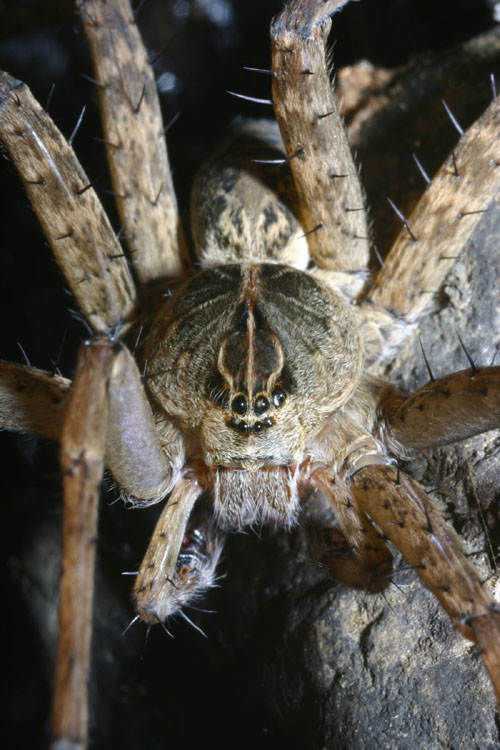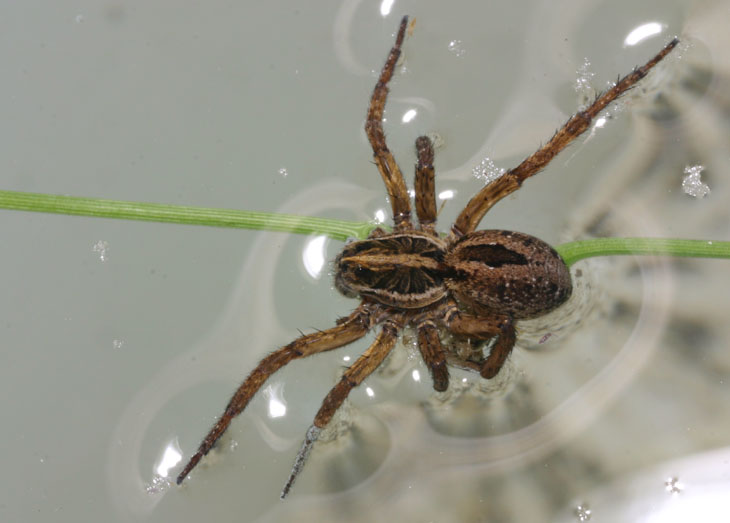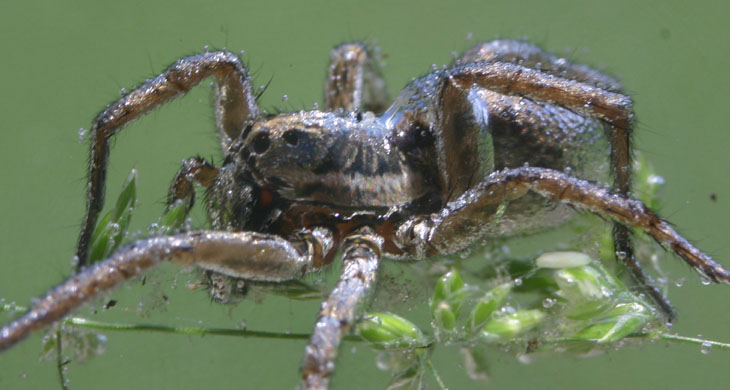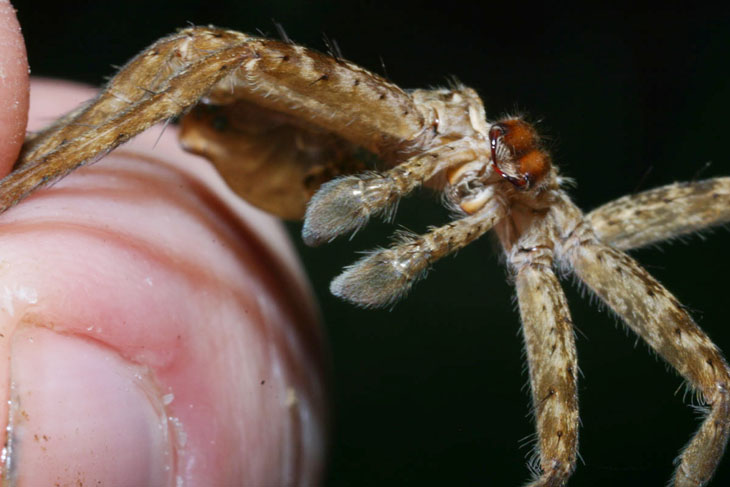 Last year about this time, I published a post about my little friends the fishing spiders, whom I call ‘friends’ not because we hang out and hammer down Pepsi together, but because my first photo sale featured one as a subject. Lately, a few have been making themselves obvious, clearly begging to be featured again, so who am I to crush their little spirits? And I say with all honesty, it’s not that I’m avoiding bunny rabbits and ducklings, it’s that I simply have not seen anything cute at all. But still, I know some people don’t want to be greeted with spiders all the time, so I’m including the detailed pics below the break.
Last year about this time, I published a post about my little friends the fishing spiders, whom I call ‘friends’ not because we hang out and hammer down Pepsi together, but because my first photo sale featured one as a subject. Lately, a few have been making themselves obvious, clearly begging to be featured again, so who am I to crush their little spirits? And I say with all honesty, it’s not that I’m avoiding bunny rabbits and ducklings, it’s that I simply have not seen anything cute at all. But still, I know some people don’t want to be greeted with spiders all the time, so I’m including the detailed pics below the break.
A little over a week ago, while staging the photo for the previous post, I espied something that can occasionally be found at the edges of ponds and streams that have plenty of reeds, seen to the left: the molted exoskeleton of a fishing spider. Spiders, and most insects, shed their ‘skins’ as they grow larger, splitting the chitin and squeezing out backwards, and then usually hiding for a while since their new exoskeleton is soft, leaving them much more vulnerable to predators. The translucent molt is left attached to whatever surface was handy, usually mistaken for a dead insect, but it’s instead a clue to be watching for the former owner nearby. When I sat down to take this image, I soon spotted the culprit hiding in the tall grasses. With a stick, I carefully flushed him out, whereupon he panicked and scampered for cover practically underneath me, but then froze and held perfectly still for some really tight closeups.
 Really tight. The cephalothorax, which is the circular head and upper body where the legs attach, was about 10mm wide, making the entire spider with legs spread not quite able to stretch across my palm. I could have made the image even bigger, which would have shown that the faint smudge on the eye right of center is actually some imperfection or injury. This one is genus Dolomedes, but I haven’t pinned down an exact species yet. They are typically found on rocks, logs, and debris at the edge of the water, and may be seen with their forelegs or pedipalps (those miniature ‘legs’ seen here tucked under the mouth) actually resting on the water, sensing the ripples from potential prey. The hairs on their feet help them spread out their weight against the surface tension of water and permits them to run across the surface as if it were solid, even as large as my specimen here. But they can also dive under the surface effortlessly, both to seek food and to hide from danger, which is very cool in itself.
Really tight. The cephalothorax, which is the circular head and upper body where the legs attach, was about 10mm wide, making the entire spider with legs spread not quite able to stretch across my palm. I could have made the image even bigger, which would have shown that the faint smudge on the eye right of center is actually some imperfection or injury. This one is genus Dolomedes, but I haven’t pinned down an exact species yet. They are typically found on rocks, logs, and debris at the edge of the water, and may be seen with their forelegs or pedipalps (those miniature ‘legs’ seen here tucked under the mouth) actually resting on the water, sensing the ripples from potential prey. The hairs on their feet help them spread out their weight against the surface tension of water and permits them to run across the surface as if it were solid, even as large as my specimen here. But they can also dive under the surface effortlessly, both to seek food and to hide from danger, which is very cool in itself.
One might suppose that they would only be seen near water sources; one would be wrong. They also hunt very capably as the wolf spiders do, wandering through the grasses and brush, so they can easily be found far from ponds and streams, far enough to suspect that they might never have seen such in their lives. For instance, the river where I got the photo above is over a kilometer away, and the nearest water source that might feature regular life within is at least a few hundred meters. But when I looked in a bucket of rainwater aside the porch today, the ‘drowned’ spider within made me pause and take a closer look.

That silvery color is a bit of a giveaway. It’s caused by air adhering to the fine hairs along the body, and forms an attendant oxygen supply when the spider dives, since they breathe through spiracles along the sides of their abdomen. Nudging the stray bit of grass that the spider clung to confirmed that my subject wanted to be down there, and in fact could have easily escaped the bucket by simply climbing the grass. This one is considerably smaller than the former, only about 30mm in leg spread, and who can say how often it might have encountered any such body of water before? Yet it took to it instantly, and demonstrated that it was capable of switching between being submerged and skating along the surface as needed. This may not be just an opportunity for seafood on Fridays, but might also serve to get the spider out of the sun during the heat of midday.

A quick poke enticed my friend to demonstrate its surface abilities too, where a few legs maintained its position atop the water while a few others check out the bit of debris under its body, ensuring that nothing tasty was in there. It’s easy to see the distortion caused by the water bending under the spider’s weight, with two legs angled downwards more to break through the surface. Yes, there’s a foreleg missing and no, that wasn’t my fault (I told you, they’re my friends!) My model here was cooperative enough for me to transfer it into my macro aquarium and shoot some ‘underwater’ detail images.

If you’re interested in shooting underwater arthropods and haven’t created a macro aquarium yet, what are you waiting for? It makes things so much easier, from providing a nice clear glass surface to photograph through, to allowing plenty of lighting options, and keeping your subject in a limited environment to prevent them from getting too far away or being obscured by suspended sediment, and even letting you control the background appearance. Even with the short depth-of-field of macro work, whatever is behind the aquarium (or within it) will produce blotches and color in the background, so sometimes it helps to put something a little more natural-looking behind the tank – in this case, the front lawn instead of the white bucket in which I had first spotted the spider. Instead of direct flash from a strobe on the camera, this is natural light, coming from above and giving an overall more realistic setting. I actually tried to obtain some shots of my subject feeding, by making a quick trip down to a pond and collecting a variety of aquatic prey – water beetles, dragonfly nymphs, and tadpoles – but the spider decided to leave the aquarium before partaking of my largesse.
And so, one last shot, returning to my specimen from the beginning of the post.

This is, once again, the molted exoskeleton of the larger spider down at the river – my finger provides a little scale. The clublike pedipalps dominate the frame, strongly indicating that this one was a male, and the chelicerae (“fangs”) are visible above them. Just like snakes, even the caps over the eyes are shed, but this particular species splits the exoskeleton horizontally just above the leg joints, so the top of the cephalothorax is out of focus to the left. Since most arthropods molt only when they feel safe, I have yet to actually witness this in action, but rest assured I’ll provide a post when it happens. And I’ll give you fair warning, too.




















































